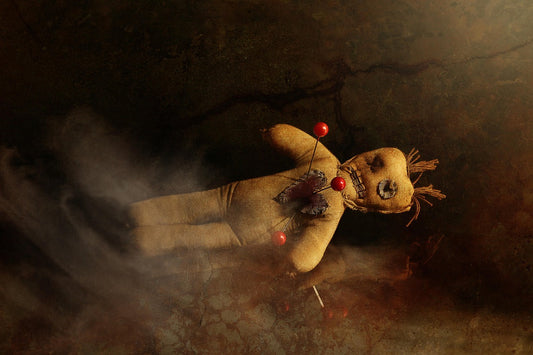 The role of Tosca was played by Sondra Radvanovsky and she absolutely killed it. I'll probably be run out of town for saying this, but as good or better than Callas. Scarpia was weak—a real disappointment, which is a shame because he is the drama.
In any case, my first experience with the LA Opera was a good one, the sound unamplified (at least at my seat) and the stage, while tiny compared to the Met, had decent acoustics.
All the sound we heard was acoustically amplified by means of strong voices and reflections. Absorptive materials were nowhere to be seen.
But, of course, this was a live production and we're interested in reproduction in our homes.
There are two ways of improving the sound in your room: absorption or diffusion. We have to see which will be best for us.
Absorption is the means by which we stop reflections. Absorb enough sound and it is stopped dead in its tracks. Heavy curtains, carpet, special-made fiberglass-filled panels, Tube Traps. It is mostly higher frequencies we can absorb. Lower bass notes have such long wavelengths it becomes difficult to trap them. And deadening a room is perhaps the last thing we want to do.
I remember years ago the debates about live-end dead-end: the area the speakers occupy is made acoustically dead by absorption and the listening area remains live - or the opposite. Neither is desirable.
Tomorrow we'll look at when it makes sense to kill off some of the sound we worked so hard to generate.
The role of Tosca was played by Sondra Radvanovsky and she absolutely killed it. I'll probably be run out of town for saying this, but as good or better than Callas. Scarpia was weak—a real disappointment, which is a shame because he is the drama.
In any case, my first experience with the LA Opera was a good one, the sound unamplified (at least at my seat) and the stage, while tiny compared to the Met, had decent acoustics.
All the sound we heard was acoustically amplified by means of strong voices and reflections. Absorptive materials were nowhere to be seen.
But, of course, this was a live production and we're interested in reproduction in our homes.
There are two ways of improving the sound in your room: absorption or diffusion. We have to see which will be best for us.
Absorption is the means by which we stop reflections. Absorb enough sound and it is stopped dead in its tracks. Heavy curtains, carpet, special-made fiberglass-filled panels, Tube Traps. It is mostly higher frequencies we can absorb. Lower bass notes have such long wavelengths it becomes difficult to trap them. And deadening a room is perhaps the last thing we want to do.
I remember years ago the debates about live-end dead-end: the area the speakers occupy is made acoustically dead by absorption and the listening area remains live - or the opposite. Neither is desirable.
Tomorrow we'll look at when it makes sense to kill off some of the sound we worked so hard to generate.
Absorbing
by Paul McGowan
My first experience at the Los Angeles Opera in the Dorothy Chandler Pavillion was last night to see Tosca. Front row, just behind the orchestra. Here's a shot from my phone as the actors took their bows. Check out the hanging prisoner in the staging.
 The role of Tosca was played by Sondra Radvanovsky and she absolutely killed it. I'll probably be run out of town for saying this, but as good or better than Callas. Scarpia was weak—a real disappointment, which is a shame because he is the drama.
In any case, my first experience with the LA Opera was a good one, the sound unamplified (at least at my seat) and the stage, while tiny compared to the Met, had decent acoustics.
All the sound we heard was acoustically amplified by means of strong voices and reflections. Absorptive materials were nowhere to be seen.
But, of course, this was a live production and we're interested in reproduction in our homes.
There are two ways of improving the sound in your room: absorption or diffusion. We have to see which will be best for us.
Absorption is the means by which we stop reflections. Absorb enough sound and it is stopped dead in its tracks. Heavy curtains, carpet, special-made fiberglass-filled panels, Tube Traps. It is mostly higher frequencies we can absorb. Lower bass notes have such long wavelengths it becomes difficult to trap them. And deadening a room is perhaps the last thing we want to do.
I remember years ago the debates about live-end dead-end: the area the speakers occupy is made acoustically dead by absorption and the listening area remains live - or the opposite. Neither is desirable.
Tomorrow we'll look at when it makes sense to kill off some of the sound we worked so hard to generate.
The role of Tosca was played by Sondra Radvanovsky and she absolutely killed it. I'll probably be run out of town for saying this, but as good or better than Callas. Scarpia was weak—a real disappointment, which is a shame because he is the drama.
In any case, my first experience with the LA Opera was a good one, the sound unamplified (at least at my seat) and the stage, while tiny compared to the Met, had decent acoustics.
All the sound we heard was acoustically amplified by means of strong voices and reflections. Absorptive materials were nowhere to be seen.
But, of course, this was a live production and we're interested in reproduction in our homes.
There are two ways of improving the sound in your room: absorption or diffusion. We have to see which will be best for us.
Absorption is the means by which we stop reflections. Absorb enough sound and it is stopped dead in its tracks. Heavy curtains, carpet, special-made fiberglass-filled panels, Tube Traps. It is mostly higher frequencies we can absorb. Lower bass notes have such long wavelengths it becomes difficult to trap them. And deadening a room is perhaps the last thing we want to do.
I remember years ago the debates about live-end dead-end: the area the speakers occupy is made acoustically dead by absorption and the listening area remains live - or the opposite. Neither is desirable.
Tomorrow we'll look at when it makes sense to kill off some of the sound we worked so hard to generate.
 The role of Tosca was played by Sondra Radvanovsky and she absolutely killed it. I'll probably be run out of town for saying this, but as good or better than Callas. Scarpia was weak—a real disappointment, which is a shame because he is the drama.
In any case, my first experience with the LA Opera was a good one, the sound unamplified (at least at my seat) and the stage, while tiny compared to the Met, had decent acoustics.
All the sound we heard was acoustically amplified by means of strong voices and reflections. Absorptive materials were nowhere to be seen.
But, of course, this was a live production and we're interested in reproduction in our homes.
There are two ways of improving the sound in your room: absorption or diffusion. We have to see which will be best for us.
Absorption is the means by which we stop reflections. Absorb enough sound and it is stopped dead in its tracks. Heavy curtains, carpet, special-made fiberglass-filled panels, Tube Traps. It is mostly higher frequencies we can absorb. Lower bass notes have such long wavelengths it becomes difficult to trap them. And deadening a room is perhaps the last thing we want to do.
I remember years ago the debates about live-end dead-end: the area the speakers occupy is made acoustically dead by absorption and the listening area remains live - or the opposite. Neither is desirable.
Tomorrow we'll look at when it makes sense to kill off some of the sound we worked so hard to generate.
The role of Tosca was played by Sondra Radvanovsky and she absolutely killed it. I'll probably be run out of town for saying this, but as good or better than Callas. Scarpia was weak—a real disappointment, which is a shame because he is the drama.
In any case, my first experience with the LA Opera was a good one, the sound unamplified (at least at my seat) and the stage, while tiny compared to the Met, had decent acoustics.
All the sound we heard was acoustically amplified by means of strong voices and reflections. Absorptive materials were nowhere to be seen.
But, of course, this was a live production and we're interested in reproduction in our homes.
There are two ways of improving the sound in your room: absorption or diffusion. We have to see which will be best for us.
Absorption is the means by which we stop reflections. Absorb enough sound and it is stopped dead in its tracks. Heavy curtains, carpet, special-made fiberglass-filled panels, Tube Traps. It is mostly higher frequencies we can absorb. Lower bass notes have such long wavelengths it becomes difficult to trap them. And deadening a room is perhaps the last thing we want to do.
I remember years ago the debates about live-end dead-end: the area the speakers occupy is made acoustically dead by absorption and the listening area remains live - or the opposite. Neither is desirable.
Tomorrow we'll look at when it makes sense to kill off some of the sound we worked so hard to generate.
- Choosing a selection results in a full page refresh.
- Opens in a new window.








